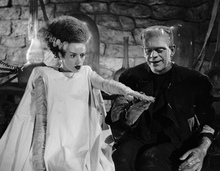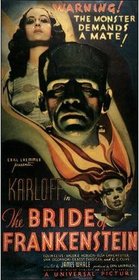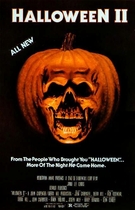Our editor-in-chief Nate Yapp is proud to have contributed to the new book Hidden Horror: A Celebration of 101 Underrated and Overlooked Fright Flicks, edited by Aaron Christensen. Another contributors include Anthony Timpone, B.J. Colangelo, Dave Alexander, Classic-Horror.com's own Robert C. Ring and John W. Bowen. Pick up a copy today from Amazon.com!
Bride of Frankenstein (1935)
The central, perhaps deliberate, irony in James Whale's masterpiece The Bride of Frankenstein is that Frankenstein's creation is called the Monster. The Monster, unforgettably played again by the great Boris Karloff, is one of the least monstrous characters in the film. He is surrounded by people more sinister, or at least more misguided, than he, yet everyone in the film fears and loathes him, even his prospective bride. In addition to offering chills, humor, and satire, The Bride of Frankenstein also provides a searing indictment of man's inhumanity to man. This is just one the factors that help it become, in this author's opinion, the best horror film of the 1930s.
The film opens with Mary Shelley (Elsa Lanchester), Percy Shelley (Douglas Walton), and Lord Byron (Gavin Gordon) discussing Mary's novel Frankenstein. She then tells them that there was more to the saga, and then proceeds to tell us the story of this film. We see that the Monster did not die, but managed to escape to the hut of a blind hermit (O.P. Heggie) who becomes the only friend in his life. Meanwhile, the evil Dr. Pretorius (Ernest Thesiger) is able to tempt Dr. Henry Frankenstein (Colin Clive) to assist him in creating a new Monster, a female to be a mate to the original Monster. When she is brought to life, her reaction to the Monster causes him to destroy the lab and everyone in it.
This is a magnificent film! Script, direction, acting, and cinematography are all near perfect. In some ways, it is more true to the spirit of the original novel than the first film. The scene with the hermit is based on an episode in the novel, and the Monster's ability to actually speak is also similar to the novel (although in the novel the Monster speaks almost like a philosopher, as opposed to the few words he learns in this film). It also makes clear the idea that the Monster is driven to his violent deeds by the cruelty of the world to him. As mentioned earlier, the Monster is most definitely not a monster in this film. In fact, he is more of a victim (first of the mob, and later of Pretorius) than a predator in this film. Although it only does so in brief periods, The Bride of Frankenstein on more than one occasion presents Mary Shelley's original concept of the Creature as a being that is driven to violence by society at large.
James Whale uses all the tools at his disposal to translate this tale, adapted for the screen by William Hurlbut and John L. Balderston, to vibrant life. More than once Whale uses religious imagery for either ironic or sincere purposes. Early on the mob captures the Monster and hoists him up onto a pole, tying his hands above him. He is used here in an obvious Christ parallel, wherein ignorant and vicious villagers blindly sacrifice the Monster to assuage all of their fears. Later in the film, as the Monster settles down to sleep in the home of the blind hermit and the hermit offers a prayer of thanks, we see a cross on the wall. As the scene fades to black, the image of the cross lingers briefly on the screen before disappearing. We see the love between two lonely souls that have finally found friendship, and the cross reminds us of the love Christ had for all people no matter their appearance. The symbolism may be a bit obvious, but it is still quite moving.
Whale also magnificently sets up the ending to be what might be the best mad scientist sequence in all of cinema. He uses the bizarre electric devices designed by Ken Strickfaden to make us believe that Frankenstein and Pretorius have truly discovered, as Dr. Frankenstein says, "the secret that God is so jealous of." Whale often shows the two doctors in extreme close-up, and many times lights them from below. He also employs a set, as he did in the original Frankenstein, which seems to reach up into Heaven itself. All of this emphasizes how unworldly and ungodly these experiments are, and Whale brilliantly delivers to us this sense of both wonder and dread.
 Friend? Elsa Lanchester and Boris Karloff in James Whale's Bride of Frankenstein (1935). Publicity still from doctormacro.com.
Friend? Elsa Lanchester and Boris Karloff in James Whale's Bride of Frankenstein (1935). Publicity still from doctormacro.com.Complementing the inspired direction is a wonderful cast. Boris Karloff, credited simply as "Karloff," plays the Monster better than anyone before or since. He can appear menacing when he needs to, but what one remembers most from his performance is the sadness and pathos it embodies. A lesser actor could have made the Monster look either ridiculous or hopelessly maudlin, but through Karloff we see a being searching for someone to care for him, despite being mercilessly persecuted at almost every turn. To emphasize that the Monster is still learning how his body works, Karloff moves very slowly; this also serves to increase the Monster's menace on those few occasions when he does move fast. Even though Karloff didn't like the fact that the Monster could talk in this film, without speech we would never have gotten to hear his joy when he says to the hermit, "Friend... good!" or his absolute sadness as he pitifully cries out "Friend?" as the hermit is led away by two strangers (one of them played by John Carradine) who try to kill the Monster. The sadness and anger in Karloff's voice when he says "She hate me, like others," after the Bride spurns him makes us feel the rejection that he feels. This is a performance that is unmatched by any later actor.
Ernest Thesiger is masterful as the maniacal Dr. Pretorius. Thesiger, a veteran of Whale's The Old Dark House, is at once menacing and hilarious. He plays Pretorius as a dandy who creates small creatures (the film utilizes special effects that still impress in the 21st Century) mostly for his own pleasure, and delights in comparing himself to the Devil. His effete manner of speaking and wicked smile utterly convince us that he is perhaps the maddest scientist ever seen. When he presents Frankenstein with the Monster again, he seems triumphant as he brings in the Monster. He is the real villain of the film, much more so than Karloff's Monster, and Thesiger easily persuades us of both his sardonic humor and his villainy.
Colin Clive returns again to play Dr. Henry Frankenstein. He wildly overacts his part, but he does it with such conviction that we soon completely believe in him. He is particularly good when Pretorius is tempting him to create another monster, especially in his reading of the line "But this isn't science, it's more like black magic." When he hysterically exults, "She's alive! Alive!" near the end of the film (in an obvious callback to his "It's alive" cry in the original film), we can't imagine it done any other way.
Perhaps the oddest and most gripping performance is Elsa Lanchester in her uncredited performance as the Bride. In her few minutes on the screen, she creates a character that makes a deep impression on the viewer. She stands still, moving her head in short jerks, much like a bird or a lizard, and she seems to have an attraction to Dr. Frankenstein. Her hiss at the Monster just before she is destroyed is chilling. It is remarkable that for a character that is on the screen for such a small time, she creates an indelible memory in the viewer.
If there is any flaw in this stellar film, it is the character of Minnie (Una O'Connor). O'Connor certainly plays her humorously; she can offer many grins. However, this kind of comic clown detracts from the film. She is an example of many similar characters in 1930s horror films that always seemed to be there just to reassure the audience that the film wasn't too scary. This type of comic foil weakened the horror films of this age, and Minnie is no exception.
Minnie aside, Bride of Frankenstein is the best horror film of the Golden Age of Horror. It combines spectacular direction, superb acting, and a thoughtful script in a way only a handful of films did at this time. In a time when many films had no musical score, it even treats us to a superb Franz Waxman score. Bride of Frankenstein is the quintessential example of everything that is wonderful about classic horror.
This review is part of our Shocktober Classics 2009: Staff Screams event.
When I was very young, I remember watching this film on TV with my Mom. When Dr. Pretorius says to Frankenstein "You think I'm mad," my mother laughed and said "How could you think anything else?"
Trivia:
Both Clive and Karloff had broken legs during production. Clive broke his in a riding accident shortly before filming started. Karloff's was broken after he slipped while filming the scene where he climbs out of the windmill ruins.









Thank yo very much
Thank yo very much